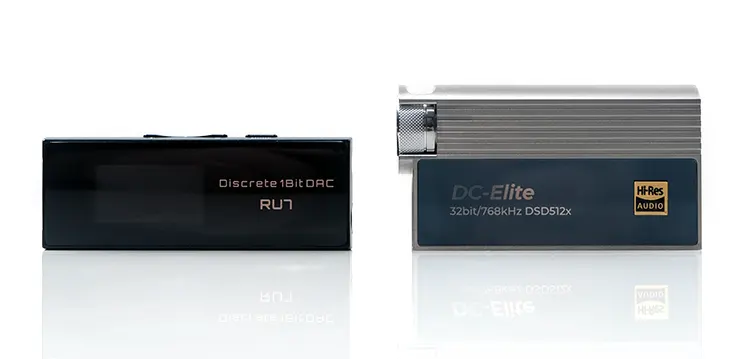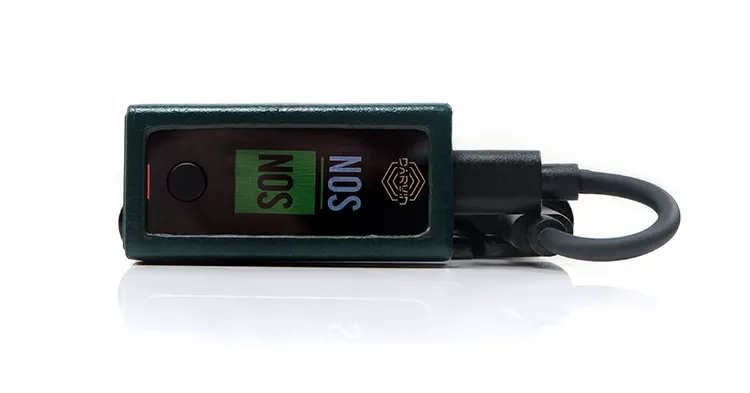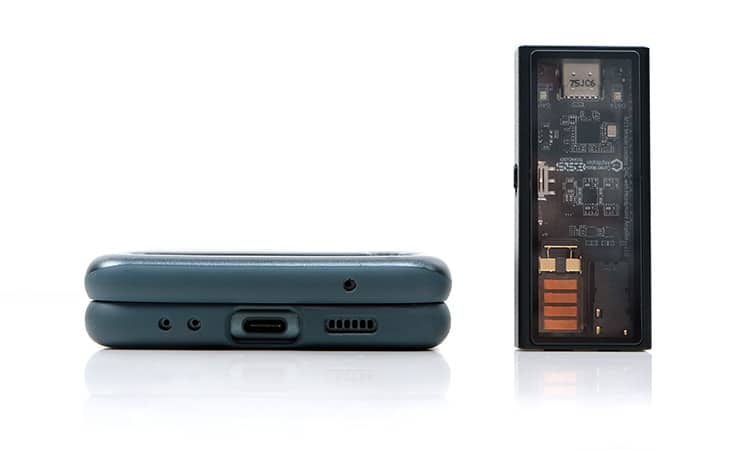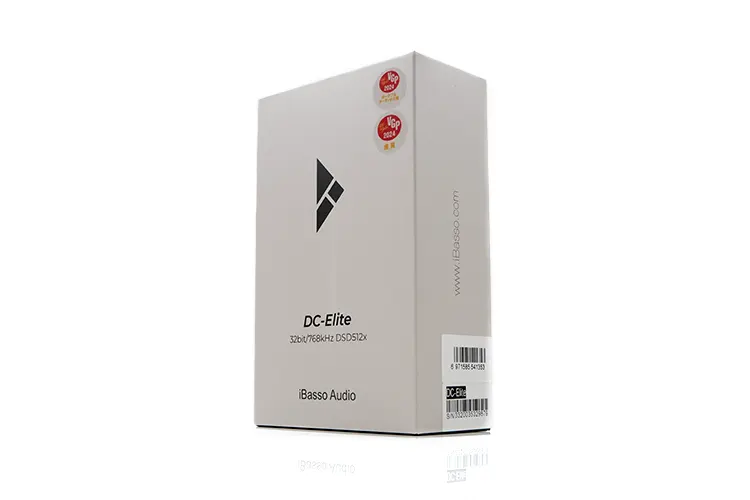Select Comparisons
The following comparisons to the iBasso DC-Elite were completed using a mix of the Vision Ears VE10, the 64 Audio Volur, and the Sennheiser IE 600.
Cayin RU7
The Cayin RU7 was released last year with our review just after it launched. This is the company’s flagship dongle and our 2023 Top Gear Award winner for best Dongle DAC.
Technical
In a way, these two dongles are a battle of the ‘firsts’.
The RU7 is the first dongle DAC to offer a balanced discrete engineered 1-BIT DAC with no FPGA and an “all to DSD” approach.
1BIT DACs are resistor-based but it is not the same as an R-2R DAC. The 1-BIT DAC benefit primarily applies to processing native 1-BIT DSD, as opposed to PCM, which is multibit.
Both PCM and DSD get processed or upsampled to DSD before being sent to the RU7’s DAC. You can also choose an “all to DSD” function from the RU7’s menu system that will allow you to upsample the output from DSD64 up to DSD256 with identifiable changes in the audio output as a result.
The DC-Elite is the first dongle to use a ROHM delta sigma chipset backed by iBasso’s in-house FPGA for decoding. We can also put forward the true 24-step attenuator from the DC-Elite as another first at this level.
The RU7 uses a switching array for volume control with a 3-segment resistor to enhance dynamic range and channel consistency.
The DC-Elite does have an edge in its decoding ceiling at PCM 32BIT/768kHz compared to the RU7’s lower native DSD256 and PCM up to 32BIT/384kHz ceiling. Neither dongle offers MQA decoding.
The RU7 does have an edge in amplification output in terms of raw numbers at 160mW on a 32Ω load and balanced 400mW on the same load compared to 162mW and 280mW respectively on the same load from the DC-Elite.
However, in terms of quoted SNR and dynamic range numbers, the DC-Elite should be the quieter of the two with a blacker background.
Design
The DC-Elite has the super build quality and materials but the lighter and smaller RU7 (25g) might be more user-friendly for potential owners.
The Titanium alloy of the DC-Elite is a confidence builder and I dare say it would better survive a drop over the RU7’s comparatively blander CNC-Aluminum build quality. That being said, both come with some nice green leather cases so this is more a moot point once slipped onto the dongle.
One differentiator is the RU7’s onboard LCD and UI menu-based control system. A feature that the DC-Elite does not offer with very little physical or visual feedback from the device itself for status and volume level save for that small LED light on the side.
Arguably, the DC-Elites UAC app adds a nice layer of granular control but only applies to Android users so Apple device users will have to ‘fly solo’ so to speak.
No denying that the stepped attenuator dial is a beauty on the DC-Elite. The RU7 volume rocker is functional and some may prefer the 100-step scale for micro-volume adjustments but nothing beats the experience of a manual dial on an audio device.
Both are SE and balanced with USB-C for OTG and USB-DAC duties. However, another differentiator is a RU7’s dual balanced and SE lineout compared to a switchable 3.5mm coaxial output on the DC-Elite.
Owners of a 1BIT iBasso D16 can technically feed their unit with the DC-Elite coaxial output if they so wish.
Performance
You will hear a big contrast in the timbre from each dongle and though I think they are a match in staging prowess, the nuanced aspects of their soundstage are a bit different with each IEM pairing I tried.
I prefer the DC-Elite with slightly warmer monitors or those that I consider to be technically very resolving such as the Vision Ears VE10. It invites more of a reference-type listening experience, enhanced by a very black background and clean and clear mids.
I find the RU7 better if I want a more enhanced bassline, a softer tone on the upper mids and highs, with a richer, warmer set of mids. It tends to blend better with IEMs that might have a spikier set of highs such as the Campfire Audio Trifecta.
The DC-Elite is more neutral sounding, and cleaner with a bit more presence in the highs and a shorter decay throughout. It has a delta-sigma polish to instrumental and vocal timbre, sounding quite pure without much in the way of rough edges or analog overtones.
The RU7 is smoother, warmer in part, and more analog in general. It delivers more in terms of staging depth and bass note body with a little more lower-mid bloom.
It is not quite as articulate or as resolving as the DC-Elite but its more natural, denser tonal quality might make it a more soothing pairing with brighter IEMs.
The staging from the RU7 is almost as wide as the DC-Elite but that slightly softer, longer decay can comparatively dull the definition in notes slightly.
The DC-Elite’s rapier-like clarity and punchier character combined with a shorter level of decay create a stronger perception of space around center images.
HiBy FC6
The HiBy FC6 was launched in mid-2023 and is still the company’s TOTL dongle DAC at the time of writing. You can find our full review of the FC6 here.
Technical
Another 180 internally from the ROHM delta-sigma inside the DC-Elite. This time we have an R-2R DAC inside the FC6 outputting to a single-ended amplification topology as opposed to balanced.
The key focus on the FC6 is a bit more than R-2R as the architecture is a trickle-down of their high-end DAP Darwin Architecture. It represents a holistic approach to digital signal management, including digital-to-analog decoding and any associated sampling and filtering techniques to acquire the desired sound signature.
The FC6 uses a discrete-designed 24BIT R2R DAC with two rails of 48 matched resistors, (0.1% tolerance), per rail/channel making it a total of 96 resistors with supporting technology for linear compensation.
Decoding is competitive with both dongles capable of DSD512 native and up to PCM 32BIT/768kHz. The FC6 will also handle MQA up to 8X but this is irrelevant these days unless you have a ton of local MQA files.
The FC6 is a single-ended amplification circuit with no balanced output so if you are looking for a 4.4mm output and some power differences along with it then the DC-Elite is the go-to choice here.
Its rated 100mW under a 32Ω load is reasonable when compared to the DC-Elite’s 162mW SE under the same load but falls away once you go balanced at 280mW from the DC-Elite.
Design
The FC6 looks tiny when sat beside the beat that is the DC-Elite. No question which of the two is the lighter either, it’s the FC6 all day long.
Do not get me wrong though, bigger is not always better. I can say the DC-Elite looks more premium with that Titanium alloy finish and beautifully knurled stepped attenuator dial.
However, the diminutive low-profile finish of the FC6 will appeal greatly to HiBy R3 II or Shanling M0 Pro owners who want to use their DAPs as transports into an equally small but better-performing dongle.
The FC6’s big 0.96″ LCD screen and menu system will be seen by some as a major benefit. There is no accompanying app similar to the iBasso’s UAC but iPhone users have no access to that app so if you need onboard visuals as an iPhone user the FC6 has an edge.
Just a 3.5mm TRS port on the FC6 and no balanced 4.4mm option. You will need an adapter for your balanced terminated cables to use the FC6. There are no LO or coaxial options either on the FC6 meaning the DC-Elite can be used as a system device rather than just a dongle DAC.
Performance
Paired with the IE 600 the FC6 delivers a juicer and fuller-sounding low-end whereas the DC-Elite is tighter and more defined over the same region. The HiBy NOS tuning also has a bit more vocal immediacy with more texture and richness to the IE 600 midrange notes up to a point.
I say up to a point because the FC6 treble is a bit uneven and can create some sharpness on higher-pitching vocal performances and treble register notes from the IE 600 pairing.
The DC-Elite sounds more refined in the same region despite having more treble extension and presence. It sounds taller and airier without aggressive treble coloration spilling into the IE 600’s mids unpleasantly.
The general sense of space is a big differentiator between the two dongles. The FC6 sounds big but it’s up close and personal with bass and vocal first and everything else falls in behind a bit more.
With the IE 600, it sounds comparatively languid with a perceived longer note decay that eats up that space a bit more. The DC-Elite sounds ‘quicker on the turn’ with enhanced resolution and better separation. Imaging sounds more accurate and complex as a result.
While not as technically proficient as the DC-Elite. The FC6 does bring out a more satisfying ‘basshead’ sub-bass experience with the IE 600 and monitors such as the Trifecta and 64 Audio Volur.
For everything else, including vocal clarity, treble smoothness, dynamic range, and imaging excellence, the DC-Elite is superior.
Questyle M15
Questyle came out with two current mode dongle DACs in 2021 and 2022, the M12 and the M15. The M15 is their current TOTL dongle DAC with the M12 our Bang For Buck Dongle DAC winner for 2021.
Technical
The last of the compared dongle DACs, this time we have delta-sigma versus delta-sigma. The key differentiator between these two dongles is their amplification designs.
The M15’s 32BIT 2-channel ES9281AC PRO DAC is a bit more commonplace and not headline newsworthy in some ways though Questyle implemented it quite well.
The ROHM DAC inside the DC-Elite would be considered a higher-grade chipset but do remember there is a significant price difference between these two DACs that would account for the ROHM unit cost.
Decoding levels are good on the M15 but not as competitive as the DC-Elite. You get up to DSD256 native and PCM 32BIT/384kHz as well as an 8X MQA hardware unfolding capability from the M15 with the only advantage on paper over the DC-Elite being MQA but that’s becoming rather niche in 2024.
The M15’s quad CMA SiP module amplification or current mode topology is one of the big differences from the DC-Elite multi-opamp amplification circuit.
It is both balanced and SE but instead of being voltage-biased it is current mode biased meaning, on paper, it is impedance agnostic, unlike a traditional voltage-mode circuit.
Therefore, it should cope better with a wider range of headphones with low levels of distortion and without requiring huge amounts of backend power, (low voltage operation).
Power is deceptive from the M15. On paper, it’s no match for the 280mW maximum output power from the DC-Elite with just 77.11mW from its balanced output. However, I can tell you the gain floor is high and the response from the M15 is very good, even with quality headphones.
One drawback with the M15 is the lack of onboard volume control. It is software only via your source, which is a horrible solution compared to the refined 24-stepped attenuator inside the DC-Elite.
Design
Until the DC-Elite arrived, the M15 was my largest dongle. Not anymore. The DC-Elite is the beefier and heavier of the two with only a similar height shared between them.
Stylistically, the M15 has a lot of charm with that top panel glass finish. It’s a unique approach on top of what is an otherwise non-descript average rectangular shape.
The DC-Elite doesn’t have anything quite like the glass panel in its locker but has better build materials, a more refined finish, and a nicer shape.
It also has onboard volume control which is sorely lacking on the M15. Not just any volume control but 24-stepped attenuation. They are complete opposites here but for me, it’s a 100% win for the DC-Elite.
Both dongles offer an LED light system for sample rates and power mode status though its position under the glass panel of the M15 is a bit easier to see.
Both offer 3.5mm TRS, 4.4mm balanced, and USB-C ports and both are compatible with iOS and Android though the DC-Elite has the additional UAC app on Android offering additional granular control on the volume as opposed to the gain switch on the side of the M15.
The M15 does not have multifunction features for its headphone jacks such as lineout or coaxial. Questyle has not officially declared an SE LO functionality with the M15 sockets unlike in the M12 which auto-switched to 2Vrms when loaded with over 600Ω.
Performance
For this comparison, I went with the 64 Audio Volur and I almost wish I had not as it exposed a lot of weaknesses in the M15’s performance when set against the DC-Elite.
The Volur has a smooth and slightly rounded timbre with good bass weight and a relaxed treble performance. It needs a neutral pair-up, one that is punchy, airy, and clear sounding, and sadly the M15 doesn’t give you as much of that compared to the DC-Elite.
I had always considered the M15 to be a dynamic-sounding dongle but to my ear, the DC-Elite takes it next level. It makes the M15 sound quite congested and narrow and to my surprise, lacks some of the punchiness of the DC-Elite’s mid-bass response.
Throw in a more holographic soundstage with better spacing and clearer imaging from the DC-Elite and you begin to realize the DC-Elite is an upgrade path for tM15 owners.
That is the Volur though. Not all IEMs will sound that way. The one asset the M15 has is a slightly smoother and more forgiving set of upper-mids. That may suit IE 600 owners a bit more.
However, I might be prepared to EQ those mids if I need to with the DC-Elite because I am less likely to sacrifice that improved dynamic range and clarity that goes along with it.
One final note is EMI during playback. The M15 seemed to suffer a lot more from EMI, (static) with my Samsung S23 Ultra compared to the DC-Elite which was very quiet in comparison.
I swapped a few cables to make sure but the result was the same. Nothing scientifically proven here, just an anecdotal observation with the Volur connected in balanced output.
My Verdict
The iBasso DC-Elite is a monster of a dongle DAC with a detailed, clean, and highly dynamic performance that I would not be surprised to hear out of higher-end DAPs. It’s a great pairing for equally capable IEMs at almost any price point.
Moderately priced DAPs should be nervously looking over their shoulders because if ever there was an answer to why the budget DAP market is less appealing then the DC-Elite firmly answers it.
Yes, it’s a big dongle, and for those looking for LCD screens, there is nothing here to excite your eyes. And for those who need warm, relaxed, or analog performances there are other excellent options on the market. It is also not the final word in pure grunt.
What the DC-Elite brings to the table is a high degree of transparency and excellent clarity making it one of my go-to choices for technically very capable IEMs to reach their potential without spending a fortune on a high-end DAP.
iBasso DC-Elite Technical Specifications
- DAC Chipset: ROHM BD34301EKV
- PCM Support: Up to 32bit/768kHz
- DSD Support: Native DSD64, DSD128, DSD256, DSD512
4.4mm Balanced Output:
- Voltage: 4.6Vrms THD+N: 0.00022% with a 300ohm load, 0.00031% with a 32ohm load
- Output Power: 280mW at 32ohm, 70mW at 300ohm
- Frequency Response: 10Hz to 50kHz -0.5dB
- Signal-to-Noise Ratio (S/N): 121dBA
- Dynamic Range: 118dBA
- Noise Floor: 3.5μVrms (Normal listening volume: <0.9μV)
- Output Impedance: < 0.4ohm
3.5mm Single-ended Output:
- Voltage: 2.28Vrms
- Output Power: 162mW at 32ohm
- THD+N: 0.00028% with a 300ohm load, 0.00056% with a 32ohm load
- Frequency Response: 10Hz to 50kHz -0.5dB
- Signal-to-Noise Ratio (S/N): 117dBA
- Dynamic Range: 115dBA
- Noise Floor: 2.4μVrms (Normal listening volume: <0.8μV)
- Output Impedance: < 0.2ohm






